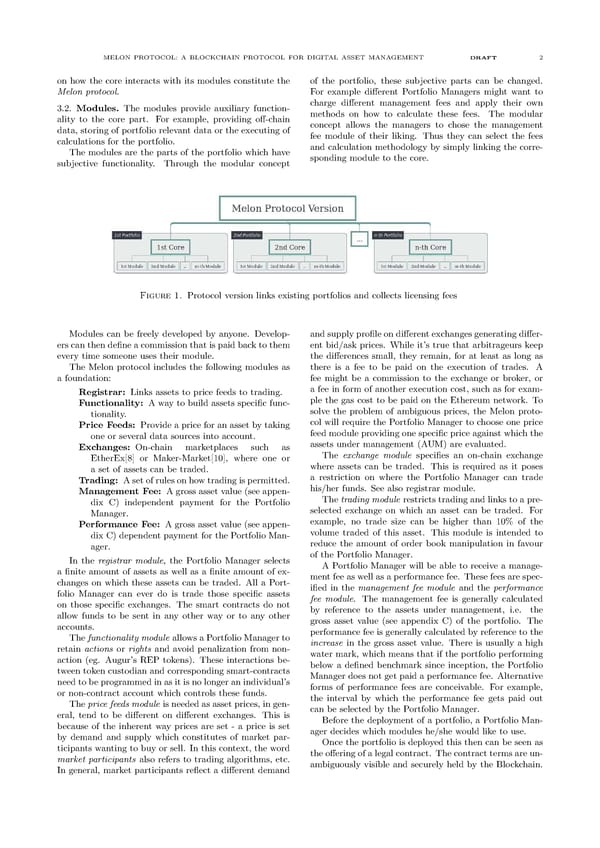MELON PROTOCOL: A BLOCKCHAIN PROTOCOL FOR DIGITAL ASSET MANAGEMENT DRAFT 2 on how the core interacts with its modules constitute the of the portfolio, these subjective parts can be changed. Melon protocol. For example different Portfolio Managers might want to 3.2. Modules. The modules provide auxiliary function- charge different management fees and apply their own ality to the core part. For example, providing off-chain methods on how to calculate these fees. The modular data, storing of portfolio relevant data or the executing of concept allows the managers to chose the management calculations for the portfolio. fee module of their liking. Thus they can select the fees The modules are the parts of the portfolio which have and calculation methodology by simply linking the corre- subjective functionality. Through the modular concept sponding module to the core. Figure 1. Protocol version links existing portfolios and collects licensing fees Modules can be freely developed by anyone. Develop- andsupplyprofileondifferentexchangesgeneratingdiffer- ers can then define a commission that is paid back to them ent bid/ask prices. While it’s true that arbitrageurs keep every time someone uses their module. the differences small, they remain, for at least as long as The Melon protocol includes the following modules as there is a fee to be paid on the execution of trades. A a foundation: fee might be a commission to the exchange or broker, or Registrar: Links assets to price feeds to trading. a fee in form of another execution cost, such as for exam- Functionality: A way to build assets specific func- ple the gas cost to be paid on the Ethereum network. To tionality. solve the problem of ambiguous prices, the Melon proto- Price Feeds: Provide a price for an asset by taking col will require the Portfolio Manager to choose one price one or several data sources into account. feed module providing one specific price against which the Exchanges: On-chain marketplaces such as assets under management (AUM) are evaluated. EtherEx[8] or Maker-Market[10], where one or The exchange module specifies an on-chain exchange a set of assets can be traded. where assets can be traded. This is required as it poses Trading: Asetofrulesonhowtradingispermitted. a restriction on where the Portfolio Manager can trade Management Fee: Agrossassetvalue(see appen- his/her funds. See also registrar module. dix C) independent payment for the Portfolio Thetrading module restricts trading and links to a pre- Manager. selected exchange on which an asset can be traded. For Performance Fee: A gross asset value (see appen- example, no trade size can be higher than 10% of the dix C) dependent payment for the Portfolio Man- volume traded of this asset. This module is intended to ager. reduce the amount of order book manipulation in favour In the registrar module, the Portfolio Manager selects of the Portfolio Manager. a finite amount of assets as well as a finite amount of ex- APortfolio Manager will be able to receive a manage- changes on which these assets can be traded. All a Port- mentfee as well as a performance fee. These fees are spec- folio Manager can ever do is trade those specific assets ified in the management fee module and the performance on those specific exchanges. The smart contracts do not fee module. The management fee is generally calculated allow funds to be sent in any other way or to any other by reference to the assets under management, i.e. the accounts. gross asset value (see appendix C) of the portfolio. The Thefunctionality module allows a Portfolio Manager to performance fee is generally calculated by reference to the retain actions or rights and avoid penalization from non- increase in the gross asset value. There is usually a high action (eg. Augur’s REP tokens). These interactions be- water mark, which means that if the portfolio performing tween token custodian and corresponding smart-contracts below a defined benchmark since inception, the Portfolio need to be programmed in as it is no longer an individual’s Manager does not get paid a performance fee. Alternative or non-contract account which controls these funds. forms of performance fees are conceivable. For example, Theprice feeds module is needed as asset prices, in gen- the interval by which the performance fee gets paid out eral, tend to be different on different exchanges. This is can be selected by the Portfolio Manager. because of the inherent way prices are set - a price is set Before the deployment of a portfolio, a Portfolio Man- by demand and supply which constitutes of market par- ager decides which modules he/she would like to use. ticipants wanting to buy or sell. In this context, the word Once the portfolio is deployed this then can be seen as market participants also refers to trading algorithms, etc. the offering of a legal contract. The contract terms are un- In general, market participants reflect a different demand ambiguously visible and securely held by the Blockchain.
 MELON PROTOCOL Page 2 Page 4
MELON PROTOCOL Page 2 Page 4